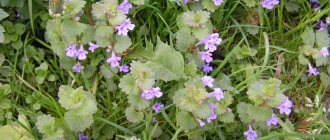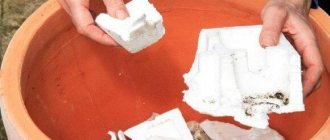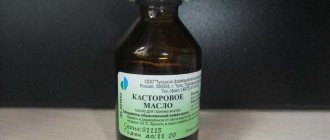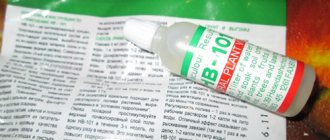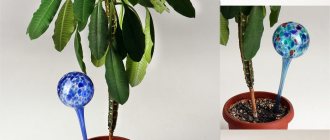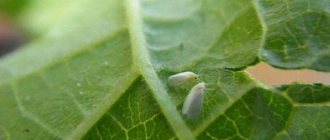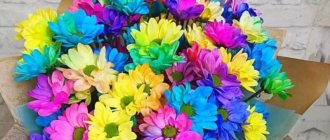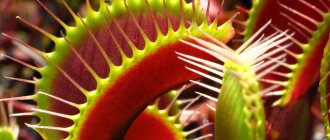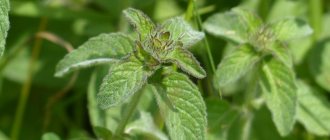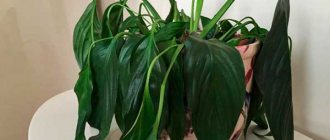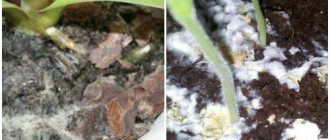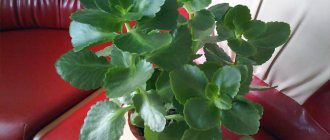The Russian and Belarusian names of ivy-shaped budra play off the similarity of the herbaceous plant with both peppermint and ivy, which quickly spreads across the ground. In nature, this grass from the Lamiaceae family creates dark green, curly lawns. In our review, let's look at the description, properties and use of ivy budra, and learn how to grow it in the open ground and in the house.
Catnip, catnip, ivy, dogmint, glechoma, moleflower, magpie - these are all names of one perennial that has medicinal properties. Since the culture is poisonous, we will look at the contraindications and precautions in this article.
Botanical description
Where does catnip grow? You can find the plant everywhere! Both in nature on the edges and clearings, in the shade under bushes and in swamps, and as a weed in a summer cottage or garden plot.
Table 1.1 - Description of the plant
| Grass parts | Peculiarities |
| Height of creeping and erect shoots | Depending on the type of shoots, from 10 to 40 cm. The stem may be covered with small hairs or fluff. |
| Leaves | Embossed leaves on long petioles are located oppositely on the shoot. The shape of the pubescent leaf is heart-shaped, the edges are carved and jagged. They have a very faint mint aroma. |
| Flowers | Two-lipped flowers are located in the leaf axils of 3-4 pieces, the color of the petals is bluish-lilac, white or deep purple. |
| Fruit | After flowering, a fruit is formed (its length is 2 mm), breaking into 4 parts. |
Information! In the photo and description of ivy bud, you can see the division of shoots into vegetative and flowering. Vegetative stems creep along the ground, taking root at the first opportunity into the ground. And flowering shoots are only erect.
If a shoot or leaf is damaged, the plant emits a specific odor similar to the “aroma” of cat urine. Perhaps the name catnip was given because of this feature of the herb.
The heart-shaped leaves retain their green color even in winter, so experts classify catnip as an ornamental crop.
Flowering of ivy bud begins in May, lasting until mid-August.
The tissues of the above-ground part of the plant contain:
- saponins and bitterness;
- vitamin C, minerals (titanium, potassium, manganese);
- aldehydes, choline;
- triterpinoids, alkaloids;
- acids: tartaric and acetic;
- cysteine, methionine, carotene;
- essential oils.
Chemical composition of budra
The main components of ivy bud are amino acids, flavone glycosides (including rutin, isoquercitrin) and triterpenoids such as ursolic and oleanoic acids.
Also present here are luteolin, β-sitosterol, saponins, tannins, linalool, limonene, menthone, terpineol, alpha-pinene, β-pinene, pulegone, rosmarinic acid, 1,8-cineole, borneol, caffeic acid, iodine, apigenin, ferulic acid acid, hyperoside.
It is known that the astringent effect of the plant is due to rosmarinic acid, and terpineol is an antiseptic substance. The anti-inflammatory effect of budra is usually associated with the presence of tannins and flavonoid fractions.
Budra essential oil is rich in terpenes, which indicates possible irritation of the gastric mucosa, other parts of the gastrointestinal tract, and kidneys when consumed orally.
To be more precise, more than half of this oil is sesquiterpene hydrocarbons (56.5 - 67.9%). The most predominant compound is germacrene D (14.1 - 20.7%).
Other substances include γ-elemene (9.0 - 16.0%), β-elemene (8.7 - 12.9%), phytols (2.8-15.6%), (Z)-β- ocimene (2.2 - 8.5%), 1,8-cineole (5.4%), β-ylangene (2.7 - 4.1%) and germacrene B (2.2 - 3.9%) . Forty-three identified compounds account for 89.1 – 96.2% of the total composition of the essential oil (Source).
Budra leaves contain polyunsaturated fatty acids such as octadecatrienoic acids (i.e. 9-hydroxy-10-trans, 12-cis-octadecadienoic acid). Small amounts of them are also present in the stem and roots. Fresh bud contains significantly less fatty acids compared to air-dried grass.
Popular variety in landscape design
Many summer residents, having discovered catnip on their property, try to remove it. But a variety of glechoma has been developed, which is highly decorative and fast growing. During the season, you can create a beautiful living carpet on your site if you plant ivy-shaped budra Variegata.
Features of Variegata:
- The leaves are decorated with specks, iridescent silver;
- The length of creeping shoots is 30-70 cm and the height of flower stems is 10-15 cm;
- Flowering begins in May, in the fall the leaves turn pinkish-green and so go into winter;
- To preserve its decorative appearance, it needs to be illuminated by the rays of the sun for 3-4 hours. In partial shade, the foliage becomes pale green and silvery inclusions are almost invisible.
Planted in hanging pots and used as a ground cover crop.
Budra ivy-leaved Variegata
Ivy leaf budra of this type has bright emerald foliage, completely covered with whitish spots. It is believed that this variegated plant loves warmth more and prefers bright lighting. If you place it in the shade, the variegated foliage loses its decorative effect.
Budra ivy-leaved Variegata
Healing properties of catnip
The perennial herb contains a huge amount of substances, including valuable essential oils, which generally have a positive effect on the human body.
The use of dognip for medicinal purposes is due to the ability of the components found in the tissues of the plant to remove toxins from our body. Lungs, kidneys, liver and gastrointestinal organs are involved in excretion. And since catnip supports the functioning of the pulmonary system and pancreas, it becomes an “assistant” in cleansing the body.
The collection of leaves, stems and flowers is carried out during flowering; the roots of the grass are not used.
Let's look at the medicinal properties of dried leaves and flowers of budra ivy, as well as their use in more detail.
Use in homeopathy and traditional medicine
- The active substances that are found in catnip have choleretic, antiviral, diuretic, choleretic, antibacterial, hemostatic properties;
- The herb is used as an antiseptic for inflammation, for healing wounds, burns, frostbite;
- Remedies from ivy bud improve the functioning of the digestive organs, relieve pain in the stomach, diseases of the spleen and liver;
- The herb helps remove sand from the bladder, strengthens the vascular system, normalizes blood pressure (but not during a hypertensive crisis!);
- Accelerates metabolic processes in the body thanks to zinc, normalizing the functioning of the thyroid, pancreas and prostate glands;
- It is used as an expectorant for diseases of the respiratory system, for which the plant was called “chest grass”;
- For the treatment of ulcers and wounds, for lacrimation, conjunctivitis, an infusion of the plant is used as an external remedy;
- The decoction relieves toothache. It is also useful for the treatment of periodontal disease, stomatitis and sore throat. Use the broth only for rinsing!
Where the medicinal properties of ivy bud are used, see photo:
As a healing agent for fractures (apply a bandage). Fresh leaves (1-2 pieces) are added to salads as a spice; they improve microflora and digestion:
Dognip essential oil is used for disinfection, to flavor drinks, and also to mask the unpleasant odor of medications. Enough to use 1-2 drops:
To treat skin diseases and reduce pain from abscesses, fresh leaves are used, which are crushed. To obtain a paste, add boiling water. Used as compresses:
Infusions of leaves and flowers are used to make baths, lotions, and washes for tumors, dermatoses, scrofula, and gout. Medicinal herbs are often included in herbal preparations that are sold in pharmacies. You can also buy dry ivy budra separately.
Watch a video about the properties and use of weeds that we are trying to remove from our plots. Also, will you find out if it is poisonous or not?
Attention! The plant is poisonous, so be extremely careful when using it.
Medicinal properties of budra
The use of budra in Europe dates back thousands of years. Galen used it in the form of compresses for eye inflammation, and the English herbalist D. Gerald used it “for tinnitus.” Hildegade of Bingen recommended budra for headaches and ear pain. In the “New Herbalist” by L. Fuchs (1543) it is described as a remedy for liver diseases, especially jaundice. In addition, in European herbalists it is recommended for kidney diseases and digestive disorders.
Before the advent of hops, the Saxons used it for flavoring and clarifying in brewing. The bitter substances present in the plant, among other things, contribute to better preservation of the drink.
The entire plant is collected during flowering. Considered expectorant and healing.
The aerial part contains flavonoids (cymaroside, cosmosin, hyperoside, isoquercetin, luteolin-7-diglycoside), triterpenoids (ursolic acid, β-sitosterol), relatively little essential oil (0.03-0.06%), the main components of which are pinocarvone , menthone, pulegone, D-germacrene, germacrane, cis-ocimene, sesquiterpenes (glechomafuran, glechomanolide), rosmarinic acid, up to 3-7% tannins, bitter substances glechomin and marrubin, saponins, lectin, reminiscent of those in legumes.
Plant preparations have an anti-inflammatory effect, which is exhibited by the triterpenes present in the raw material.
This plant is not used in scientific medicine, although a lot of research has been carried out in various directions, including oncology. In particular, in in vitro experiments, sesquiterpene lactones exhibited a pronounced antitumor effect. But in folk medicine it is widely used, primarily the leaves and aerial parts. In Italy it is used for arthritis and rheumatism.
Budra is widely used in Chinese medicine for a variety of diseases: cough, erysipelas, abdominal pain, dysfunction in women, dysentery, jaundice.
In homeopathy it is used for diarrhea and hemorrhoids.
Contraindications and side effects. Negative health effects and side effects are usually not observed when used in recommended therapeutic doses. Fatal poisonings have been reported in horses after eating large quantities of fresh plants. Mice fed only budra died within 3-4 days. But I think none of us would think of eating only this plant.
And yet, despite the fact that modern books on the use of wild plants for food are unanimous in presenting it as a salad crop, it is better to be careful. The essential oil components contained in it can have a strong irritant effect on the gastrointestinal tract and kidneys, and in large quantities exhibit a hepatotoxic effect (in particular, pulegone present in the oil, although there is much less of it in budra than, for example, in pennyroyal) .
Side effects and contraindications
Budra is a very useful herb with healing qualities. But any plant cannot be taken without measure and without consulting a doctor when treating diseases. In addition to the medicinal properties, ivy budra also has contraindications, since the plant is a poisonous crop.
Should consult a doctor before use:
- nursing mothers and pregnant women;
- those suffering from chronic pathologies of the liver and kidneys;
- patients with reduced acidity of gastric juice;
- and with increased blood clotting.
Use with caution at high blood pressure. The regimen and dosage must not be violated! If taken in large quantities, the plant will cause poisoning.
Symptoms that the body has been poisoned with budra:
- increased body temperature;
- slow pulse;
- rapid breathing;
- increased salivation;
- bleeding.
You should immediately take activated carbon or calcium chloride and call an ambulance.
Planting and caring for budra
Species ivy-shaped budra as a herbaceous plant for open ground requires very little care. The Variegata variety will cause a little more trouble. Golden October is rare, but according to reviews it is as unpretentious as a wild plant.
Dogmint takes root well, no matter how it was planted - from a container, with bare roots, seeds or cuttings. It is important to water the bud regularly at first, and choose soil that is at least somewhat fertile.
The offspring of the species dogmint planted in the spring will quickly grow in all directions, and by the fall they will cover a significant area. With the Variegata variety this will not happen so quickly; it needs to be provided with moderate regular watering.
Ivy budra is planted in the sun or partial shade. No particular precision is required when placing dognip - in less than a season it will spread in all directions. The thicker the bushes are planted, the faster the ground needs to be covered.
Growing a flower or weed
On their plots, gardeners grow ornamental varieties in hanging pots or as ground cover plants. The variegated variety Variegata is popular among Russian flower growers. It blooms from May to August, but there are few flowers compared to ivy bud. All the decoration is in the leaves with white or silver splashes.
Another variety stands out for its spectacular heart-shaped leaves - Golden October, which can be found with ivy budra in the Plantarium (plant identification atlas). The foliage of this variety is dark green. The surface of each leaf is covered with small golden spots. When the heat subsides in August, the color of these spots is especially rich.
All varieties of budra are unpretentious to growing conditions.
It is only important to ensure:
- sufficient amount of sunlight in the flower bed;
- The flower is unpretentious to the composition of the soil, but for cultivation it is better to plant it in slightly acidic, slightly alkaline soil or with a neutral pH. If the earth is strongly acidified, then crushed chalk, slaked lime or dolomite flour are added in advance for digging;
- Watering is carried out regularly, the crop does not like dry soil, the leaves become small and lose their decorative appearance.
If catnip is grown indoors, then the grower does not have any problems, since all varieties of catnip are unpretentious when grown in pots or hanging flowerpots.
What do plants need to be provided when growing at home?
- Bright place. It is best to place the pot on a windowsill that is oriented to the southwest or southeast;
- The room temperature is maintained within 20 ° C. In winter, it should be reduced to 10 ° C for the rest period. In the winter months, watering is carried out once every 2 weeks;
- The soil is suitable from the garden, mixed with sand and humus in a ratio of 1:1:1. For planting ivy bud (glechoma hederacea), you can purchase a “Universal” substrate at a garden store;
- Increased growth is observed in the spring after rest, so from April to September it will be necessary to apply fertilizing (mineral complexes for indoor plants) once a month for beautiful flowering and decorative leaves. From September to November, fertilizing should be done once. In winter, fertilizers are not applied;
- All varieties of catnip love water. Irrigate abundantly from the moment the flowers bloom until the berries ripen. By September, watering is reduced to 2 times a week. It is advisable to periodically spray the foliage with warm water;
- During the daytime, young bushes should be shaded from direct sunlight during spring and summer;
- The decorative flower is propagated by vegetative creeping stems, cuttings or spring sowing of seeds.
In the spring, before all processes are activated, the plant must be pruned to form a neat bush. The twigs remaining after cutting are usually used for propagation. Transplantation is performed only in spring if necessary.
Use of budra in everyday life.
Budra in the medicinal garden. Although budra is ignored by official Russian medicine, it has been used in folk medicine since ancient times and in quite a variety of ways. And, characteristically, people preferred to use it fresh. In the Vladimir province, people called budra a chest grass; it was believed that it was especially good for long-standing, difficult-to-treat diseases of the upper respiratory tract, associated with sputum production and a runny nose. In other provinces, the grass was also called forty-year-old grass, tumor grass, and dog mint. Dahl also cites the following popular nicknames for budra (hereinafter the quote): “podbiruha, ivy vyat. catnip Voronezh. dog mint Smolensk. southern consumable Petersburg molehill forty-unhealthy, little ram, dushmyanka? (it’s not fragrant), catnip.”
Budra is considered a mildly poisonous plant, so when consuming it, you must adhere to the recommended dosages. It is used as an antiseptic, anti-inflammatory, expectorant, and wound healing agent. Sometimes they mention anti-sclerotic, anti-diabetic, and anti-cold effects. Used for diseases of the bladder, kidneys, gastrointestinal, bronchitis, liver diseases. Externally used for compresses and washes and baths for gout, skin diseases, wounds.
It is curious that in some European countries budra is included in pharmacopoeias. Moreover, in Brazil and the USA, where it is not found in nature, it is specially grown for use for medicinal purposes.
Fresh budra grass can be picked from May to September. In some years it grows actively even in October. So its use is not excluded even in this autumn month.
Infusion . (according to Makhlayuk) Infuse one teaspoon of fresh herbs in one glass of boiling water. Drink 1/4 cup of warm infusion 2-4 times a day. Recommended for cough, asthma, chronic chest catarrh, pain in the bladder, persistent chronic runny nose, kidney stones, liver disease, and various gastrointestinal diseases.
Decoction. (according to Makhlayuk) Boil one tablespoon of herb in one glass of water and leave until cool. Use for washing suppurations, skin rashes, boils, dermatoses of various origins.
Expectorant collection. (according to the Pastushenkovs) Take cleft grass, cocklebur grass and budra leaves in equal parts. Pour a tablespoon of the mixture into a glass of hot water, boil for three minutes, leave for half an hour. Use ½ glass 3 times a day after meals.
Budra on your table. In Europe (Germany, Czech Republic, France), young budra leaves are used as spicy additives for meat dishes, and used in salads along with tomatoes and cucumbers. It is believed that budra heals the gastrointestinal microfauna, improves digestion, and stimulates appetite. The budra herb has a bitter taste and a spicy, pleasant smell. Adding budra to meat dishes (kebabs, fried and stewed meat, goulash, etc.) improves the body's absorption of fats, and thus promotes weight loss.
In previous eras, when Russian housewives made bread kvass themselves, each had her own special secret recipe for the herbal flavor of the drink. Often, budra leaves were used to flavor kvass along with mint, thanks to which it acquired a piquant bitterness.
How to destroy plantings?
Many summer residents think how to get rid of ivy budra? Therefore, we will consider both how to propagate the plant and how to limit its spread throughout the area if it is planted.
To prevent the growth of weeds, mowing of bushes is usually used. But the manipulation must be performed before the seeds are ejected.
Agrotechnical options on how to prevent the formation of a green carpet on the site:
- Strictly observe crop rotation standards, it is important to maintain the timing, methods and sowing standards;
- Regularly loosen the soil;
- Carry out deep autumn tillage.
Chemical methods include the use of herbicides based on triclopyr during the flowering phase.
In 1991, scientists discovered that it perfectly prevents the growth of ivy-shaped bud (borax). All flower and ornamental crops react positively to the drug with boron. And only catnip is intolerant of boron.
Cultivation for decorative purposes
Currently, it is used as an ornamental ground cover plant, primarily its variegated form, which is decorative almost the entire season. This is an excellent plant for shaded areas, but sometimes it is even grown in containers. The plant reproduces by pieces of shoots with adventitious roots. They are separated from the mother plant and planted, slightly deeper in a previously prepared place or simply under trees. When planting, water.
Despite all its unpretentiousness, budra does not like heavy soils and bright sun. Interestingly, the plant does not tolerate excess boron well. In addition, it is damaged by some pests and is affected by rust and powdery mildew.
But in agriculture it is considered a weed, which is controlled with herbicides to avoid poisoning of farm animals.
How to propagate?
In nature, grass conquers territories very easily. Roots are formed in the leaf internodes, which take root upon contact with the soil. This can be used in spring and summer for reproduction. For example, place a container with soil near an adult bush and pin the shoot for rooting. After 4-5 weeks, you can separate the shoot and grow the seedling as an independent bush.
When describing ivy budra, we noted that its shoots are vegetative and flowering. Therefore, experts recommend choosing vegetative stems for cuttings.
Propagation by cuttings
Cuttings cut in spring and summer can be easily rooted both in water and in moist soil.
Rooting in water:
- Cuttings of 7-10 cm, which have 2-3 internodes, are cut, the leaves are removed;
- The branches are immersed 1 cm deep in a container with water. It is advisable to shade the container from the sun, because in the dark the roots will appear faster;
- The water must be changed every 3 days, adding crushed activated carbon to it (1 tablet per 200 ml of water);
- After 5 days, the first small roots will appear. When their length reaches 2 cm, the cuttings can be planted in the ground.
If you use a substrate for rooting cuttings, then first select a container with a lid. The soil is used well moist and loose. After planting the cuttings, the container is covered with a lid or film to create greenhouse conditions. The place for rooting is chosen dark and warm. Periodically open the cuttings, remove condensation from the lid and moisten the soil.
When leaves appear at the leaf nodes, rooting has been successful. The shelter is removed and the cuttings are replanted along with a lump of earth.
Growing from seeds
Planting ivy budra in a flower bed or in a corner in the garden can also be done with seeds.
You can sow seeds in early spring and autumn. The emerging seedlings have good winter hardiness and will easily tolerate frost.
Planting catnip with seeds:
- the area must be loosened;
- remove all weeds;
- moisten the soil;
- sow seeds in any order on the soil surface;
- sprinkle with a thin layer of soil, compacting it slightly;
- Until the seedlings appear, the beds are watered 2 times a week.
And then the bushes will grow.
Treatment of cancer with alcohol tincture
Tincture of budra ivy in alcohol is one of the most effective home remedies recommended by alternative medicine against cancer. The drug stops the spread of the tumor, prevents the degeneration of benign tissues into malignant formations, and improves overall health.
A prerequisite is to begin home treatment only after medical consultation; taking even the most harmless herbal remedies without the permission of a specialist is strictly prohibited. Preparation:
- Place fresh herbs (100 grams) in a glass bottle.
- Pour in pervach, alcohol, and high-quality vodka (1 l).
- Shake the bottle vigorously several times and leave to infuse in a dark, cool place.
- Strain after two weeks and store in the refrigerator.
Article for you:
Medicinal properties of the butterbur herb and its use in folk medicine
Use 15-20 ml of home remedy three times a day. Allowed to be diluted with a small amount of water. It is better to take it after a meal.
Traditional medicine suggests treatment in courses. After each month of use, take a long break - 2-3 weeks. If the disease progresses rapidly, treatment may take up to a year.
In the early stages, it will be possible to stop the spread of cancer within 6-8 months. You should not refuse drug therapy - herbal medicine serves only as an auxiliary remedy.
Landscape use
The use of ivy bud in landscape design is equally good as a ground cover plant in the garden, in difficult areas (where it is difficult to plant a lawn) and in indoor floriculture.
Variegated varieties are used in combination with garden flowers. Catnip does not harm other plants in the garden.
Catnip can be applied at the base of fruit trees to sod the soil. The ground cover delays the evaporation of moisture from the ground and prevents the development of fungal pathogens.
Budra ivy grows well in the city, because it easily tolerates polluted air. Many people use it in urban landscaping - for courtyard lawns, in public gardens.
Boudra recipes
Infusion: For 1 tsp. fresh herbs, take a glass of boiling water, leave for about an hour. Take a quarter glass 2-3 times a day to cure diseases of the liver, gastrointestinal tract, bladder stones, and chronic runny nose.
Decoction: For 1 tbsp. l. dry herbs, take a glass of water, boil and leave until completely cool. Used externally to treat rashes, dermatitis, purulent wounds.
Expectorant collection: Prepared from 1 part of budra leaves, part of cocklebur and coffin. Take 1 tbsp. l. mixture, boil for 3 minutes in a glass of water, filter after half an hour. Take half a glass 3 times a day.
Medicinal budra is a universal plant that looks beautiful both on lawns and at home. Its charming purple or blue flowers complement other crops effectively, and the young leaves are used to treat human diseases.
I liked the article! Rate it.
Questions have arisen regarding cultivation! Write in the comments.
Diseases and pests
Catnip that receives quality care rarely experiences illness. Among the pests that can bother you are spider mites, aphids and whiteflies.
Table 1.2 – Signs and methods of controlling harmful insects
| Insect | Signs of appearance | Ways to fight |
| Whitefly | The leaves turn yellow and fall off. Small butterflies sit on shoots, leaves, flowers. | Rovikurt, Aktara, Aktellik, Konfidor. You can use a solution of laundry soap. |
| Spider mite | The leaves turn yellow and fall off, revealing a silvery thin web. | Aktellik, Fitoverm. In room conditions, you can rinse the leaves in the shower and irradiate them with ultraviolet light for 2 minutes. |
| Aphid | The leaves become sticky, then curl up, the buds stop developing and fall off. | Actellik, Decis, Fitoverm. Infusions of nettle, wormwood, laundry soap. Dusting bushes with ash. |
Ask a question
Gardeners often use this evergreen plant as a ground cover crop in their country house or garden. Ivy budra decorates the garden and helps protect flower beds and tree trunks from excessive drying out and the appearance of weeds. And some of the summer residents are trying to remove the catnip thickets from the site, classifying it as a weed. Difficulties may arise when growing even such an unpretentious crop. Let's look at what problems arise:
1) Flowering does not occur or there are very few flowers. The reason is lack of light;
2) Spots appear on the leaves in the spring. If the sun's rays hit the plant during the day, they can cause leaf burns;
3) The leaves turn yellow and dry out. Lack of moisture and lack of microelements leads to leaves drying out and falling off;
4) Buds are not formed. If there is a lot of nitrogen in the soil, buds do not form, but green mass increases.
It is not difficult to grow ivy budra on the plot. Whether to use it to decorate the garden or to get rid of it is up to you, summer residents and gardeners.
Reproduction of budra by cuttings
The simplest way to propagate catnip is from cuttings:
- Take a cutting from the mother culture and place it in damp sand or water;
- After a few days, roots will begin to form on it, after which the plant can be planted in the prepared soil;
- A separate pot will help contain active growth.
Medicinal budra is an unpretentious plant, but if conditions are violated, diseases develop.
When and how to collect budra for medicinal purposes
Unlike other medicinal herbs, dognip can be harvested throughout the growing season. The aerial parts – leaves, shoots, flowers – have healing powers.
The most beneficial substances are contained in ivy budra, which was collected in hot, dry weather. The shoots of the plant are lifted and trimmed with a knife or scissors.
How to properly dry and store dog mint
It is impossible to dry budra under a hot roof or in another room adapted for quickly removing moisture from plants or products. The essential oils contained in dog nip evaporate at temperatures above 30 °C.
The ivy budra is spread in a thin layer on white paper (newspaper cannot be taken). Leave in the shade with good ventilation. As soon as the top layer dries, the grass is carefully turned over to the other side. Do not stir or stir dog nip.
Dry herbs can be stored at room temperature in sealed jars or cardboard boxes for no more than 1 year.
Ivy plants
Ivy-like plants grow along roadsides, river banks, fields and meadows. In winter their foliage is green. It is round or heart-shaped, the edges of the foliage are crenate. The leaves grow, then age, and are then replaced by younger ones. It grows from the end of April until the buds open, and then begins to grow after flowering ends and almost until frost. The flowers are two-lipped, 2-6 pieces each, located in the axils of the foliage.
Description of the ivy-leaved ampelous budra
This burda has a stem up to 60–70 cm long. The stem has branches that are directed upward and stand straight. When the crop begins to bloom from May to July, the buds are light azure or pale purple. Next, the fruits ripen and fall into four smooth nuts.
For your information! The flowers and foliage do not emit a very pleasant smell, so the plant has another name - “wild mint” or “dog mint”.
Where does it grow
Culture is growing in all regions of Russia, it just doesn’t exist in some areas beyond the Urals. Most of all, the grass likes floodplains and fertile alluvial soils.
Ampelous budra can grow in a flowerpot, flower pots, or baskets.
Budra in a flowerpot
For planting, mix 1 part peat and 1 part sand as soil. First, a cutting is planted in a flowerpot, covered with film and placed in a warm room with good but diffuse lighting, that is, not in direct sunlight. Constantly monitor the soil moisture. The flowerpot or flowerpot is placed in a permanent place and covered with film. If the air temperature is below 10°C, then the containers are brought from the street into the apartment.
Growing and caring for ivy bud
Dog mint does not require fertilizing, being content with what it got when caring for neighboring plants. Only shoots that have spread greatly or have lost their decorative effect due to drying out are pruned. Budra does not require shelter for the winter.
Weeding and mulching of the soil are not carried out. Dognip, a year after planting or even at the end of the first season, will spread so much that it can protect the roots of large plants from overheating and loss of moisture.
Being a malicious weed itself, budra does not allow it to grow and “survives” from competitors’ sites. So you need to keep an eye on small ornamental plants with a shallow root system - they will not be able to withstand independent competition with a dog plant.
Possible problems during cultivation
Ivy budra is a plant that is resistant to external influences, which is much easier to plant on the site than to later remove it from there. There is only one problem with species dognip - it cannot be completely destroyed.
Budra grows worst of all in poor, sandy and constantly wet or dry areas. The white-edged form needs more light and water than the species dogmint.
Excessive watering will cause all parts of the plant to rot. In the south, without irrigation in the hot summer, the roots cannot obtain enough moisture, for which reason the leaves of the bud dry out.
Ivy plants
This type of grass is a perennial and evergreen plant. The branched creeping stem can reach 50 cm. The leaves are most often round or heart-shaped with denticles along the edges or slightly wrinkled.
Reproduction occurs by seeds or cuttings. Many ivy plants tend to bloom. They prefer light, and the air temperature for their favorable growth should reach an average of +20 ° C. They are unpretentious to the soil, the main thing is that it is sufficiently moist and not dried out.
Important! Ivy grasses spread their stems along the ground, so they quickly cover the area. These flowers include common ivy, philodendron, clerodendrum and others.
